"All of nature begins to whisper its secrets to us through its sounds. Sounds that were previously incomprehensible to our soul now become the meaningful language of nature." -Rudolf Steiner
For millenia, humans have looked to the heavens for answers about the cosmos.
And one of the main reasons I write what I do for all of you is to help give you -- as I've said many times -- is an awareness and an appreciation for what we've learned, what we think we know, and how we think we know it.
Which is why I was a little bit confused when I read this article from Science News:
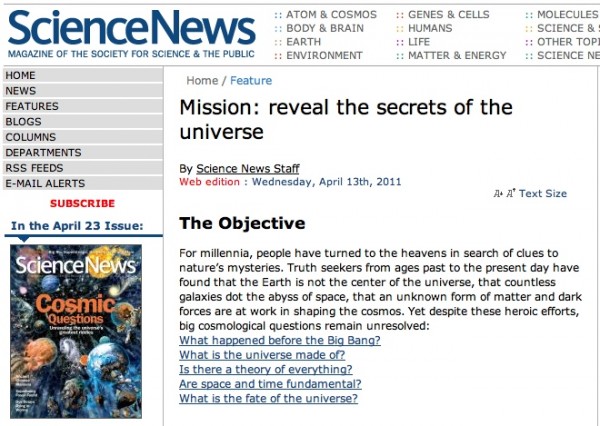
Unsolved?! These guys????
But then I thought, what an opportunity this is, to remind people that these are problems we actually know something about! Let's take a look.
1.) What happened before the Big Bang?
We know this; and if you've been reading the articles here, you know this: inflation! It not only sets up all the initial conditions we need for the Big Bang, it also gives us the seeds for all the cosmic structure we see in our Universe today!
Now, we don't exactly think inflation is the entire story; it is, mathematically, incomplete, which means we think something must have caused it. At this point, though, everything you hear about it -- colliding braneworlds, a cyclic Universe, a rejuvenated Universe, etc. -- is speculation, and nothing more. Some models have been falsified while others have not (and some can not), but hey! We know what came before the Big Bang!
What about the second one?
2.) What is the universe made of?
This changes over time, but we know it in extraordinary detail! In fact, all of our observations -- of large-scale structure, of clusters, galaxies, of the leftover radiation from the big bang, of the Lyman-alpha forest, of gravitational lensing, of the primordial elements -- all point to the same picture: a Universe that is, today,
- 72% dark energy,
- 23% dark matter,
- 4.6% normal atoms, and
- just under 0.01% radiation.
These relative percentages were different in the past (see here), and the best precision measurements come from the fluctuations in temperature from the cosmic microwave background.
Now, that isn't to say that we know what dark matter or dark energy are. In fact, there was a paper that came out today from one of the leading teams searching for dark matter. (They didn't find it, yet. See Sean's writeup.) But astrophysically, we know they're there. Figuring out what causes them/what they are will be one of the great challenges for the 21st century.
3.) Is there a theory of everything?
Fair enough; this one's a secret. Lots of people think that at a high enough energy, all four of the fundamental forces -- gravity, electromagnetism, the weak force (which makes radioactive decays), and the strong force (holds nuclei together) -- unify together and are really just the same force! Now, this may not be true. Although electromagnetism and the weak force unify, no one is certain that the strong force does.
If it does unify, weird things will happen in the Universe. What do I mean, weird?
Well, for one, the proton will decay, and be fundamentally unstable! No such thing has been observed, and so we think that perhaps the strong force doesn't unify. String theory -- that you've heard so much about -- is predicated on the assumption that all four of these forces (including gravity) unify at an even higher energy: the string scale. Such a theory is possible, but again, no evidence for it, and plenty of evidence thus far (no SUSY, stable protons, no flavor-changing neutral currents, etc.) against it. But we don't know how this will turn out. Perhaps the four fundamental forces are connected in a unified way, perhaps not. The idea is attractive, but uncertain.
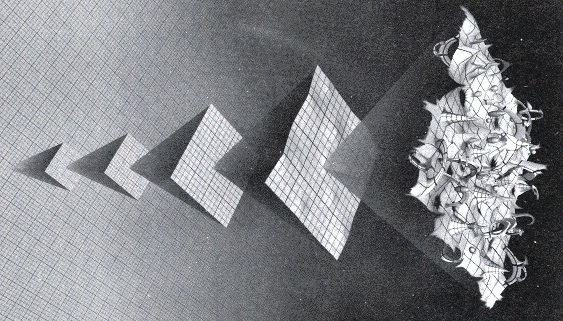
4.) Are space and time fundamental?
Well, this one's easy: no. At least, not at a quantum level. Because "position" isn't even a definitive quantity. Neither, for that matter, is "time" (see our buddy Heisenberg). Sean Carroll has discussed this at length, and as long as when you say fundamental, you mean an irreducible, quantifiable and measurable property of every part of the Universe, I think we can safely say no, space and time are not fundamental.
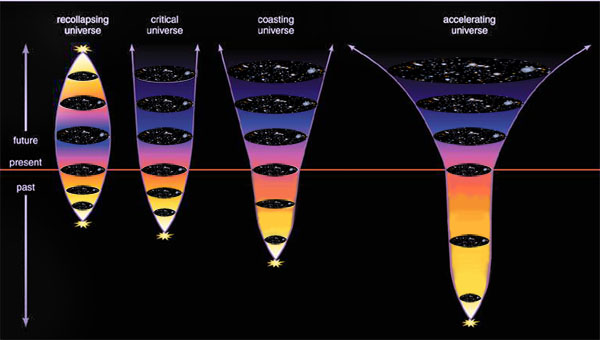
5.) What is the fate of the universe?
Ice. Definitely ice, frosty. It's dark energy that tells us this is our fate:
- The expansion of the Universe will accelerate, and everything that isn't gravitationally bound to us will speed away, and eventually red out, leaving our observable Universe.
- Everything that is bound to us -- which is our local group, including our galaxy, Andromeda, and a few smaller, satellite galaxies like the Triangulum galaxy and the Magellanic Clouds -- will continue to form stars, go through the life-and-death cycle, until all the fuel for stars is used up.
- After trillions of years, everything will contract and cool, leaving us with some stellar corpses and dead rocks. Eventually, gravitational interactions will force these things to fly apart from one another, as even the giant galaxy we will become will decay.
- And then, perhaps, if the grand unified theories are correct, even the protons making up the atoms will decay away, leaving us with nothing except a cold bath of radiation.
Inspiring! Well, if not a little macabre. But look at all we know! There are still plenty of things to learn, but I'm much more amazed at how far we've already come. Hope you've enjoyed it!

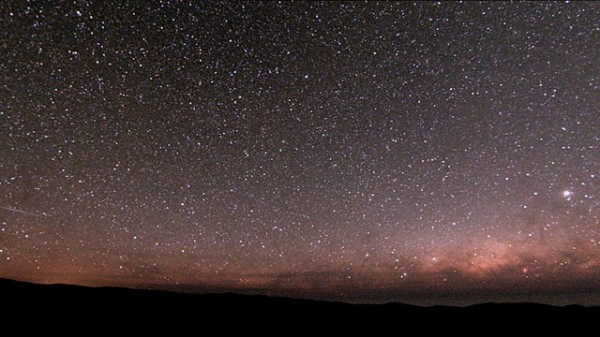


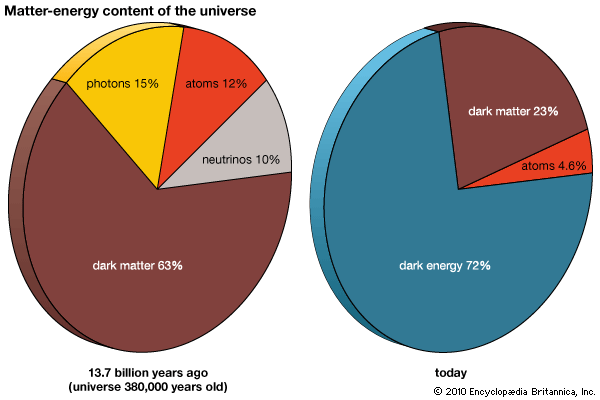
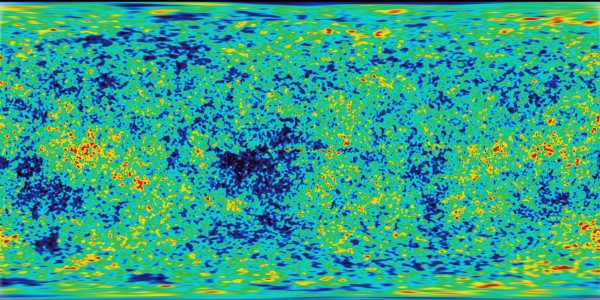
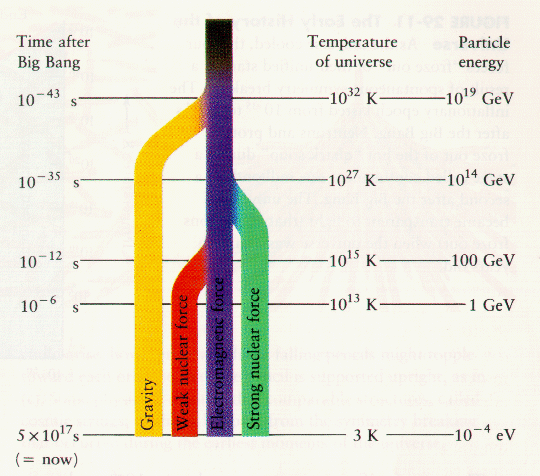

Hey, what happened to all those neutrinos? I thought, once a neutrino, always a neutrino!
Science journalists suck. They'd rather have an appealing headline that's misleading ("Darwin was wrong") than actually try to spell out the facts. We need more science journalists who are actually scientists (thanks for the explanations, real scientist).
btw., that Mercator projection of the background microwave radiation is pretty cool... I could almost hallucinate South America and Africa in it.
Who's to say that another universe won't pop out of that cold bath of radiation?
Mind blown. Again. Thanks Ethan.
Ethan, you're statement about strong force unification is not accurate. Just because we don't see proton decay does not mean the strong force does not unify. It only means that those GUT models that predict proton decay aren't correct.
Furthermore (and more importantly), proton decay was a feature of earlier attempts to form GUT theories (and don't forget, the original reason Guth came up with inflation was to explain why we don't see the magnetic monopoles predicted by those early GUT models). My theorist colleagues tell me that more modern attempts to form GUTs do not suffer from the proton decay problem.
On another note, I think inflation is a very interesting idea, and is probably correct. But I think you're a bit too cavalier about it. It's not true that we KNOW there was inflation. It's a convenient class of models, in that it solves a few of the problems we encounter in understanding the early universe. But it makes no predictions (beyond the things we already had observed) and it is not testable--at least, not at the moment. On that basis, one simply cannot argue that the evidence in favor of inflation is any stronger than the evidence was in favor of the four-element model of the middle ages, for example. Exaggerating our certainty in a model doesn't make that model more credible.
Speaking of hallucinating, I seem to perceive a pattern (or two) in the WMAP map. Both are sinusoidal. One begins has an that encompasses most of the N-S range. It starts at the lower left (the diagonal swatch of red), then arcs upward to the horizontal patch of red at middle top, then [admittedly less "obviously"] curves back down, symmetrical with the upward curve, to the lower right. The overall impression resembles the night/day divide on a Mercator map of the earth.
The other has a lesser amplitude, and is about 180 degrees out of phase with first one. It begins at the big red/yellow patch at the left 'equator' and connects with the similar patch at the right 'equator' by way of a tenuous string of patches that dips south to the middle of the map and then back north.
On a globe, both of these would be Great Circles.
I don't mean to imply that the pattersn (if they even exist!) are in the CBR, but suspect that they are artifacts of incomplete compensation for Doppler shift caused by Earth's movement.
Anybody else see these?
I believe that there have been many studies showing that the universe as a whole is rotating. Such rotation would cause intensity to increase in a wave pattern (as long as the rotation doesn't move the frequency out of the sample band altogether)
Awesome post.
I picked up a copy of Scientific America that has an article regarding Inflation, but haven't had a chance to read it yet. Anyone seen it already?
The pie chart with Dark Energy as 72% of the Universe seems premature. As far as i can tell, Dark Energy can not, even in principal, be used to power your toaster. So it's not something that can be converted to mass with e=mc^2. It could be (and i've no idea if this is on the table, but there are lots of ideas on the table) that dark energy is in some sense a decay or weakening of the fabric of the Universe. It's possible that it's not a force or energy at all. Gravity is 35 magnitudes weaker than the next strongest force. It gains be being always attractive, and accumulates with mass. Dark Energy is weaker still. It gains by being always repulsive (you can say that again), and accumulates with space. Over small distances, like to the Andromeda Galaxy, it's so small it can be ignored. On Cosmic distances, roughly billions of light years, it's huge.
Also, i get the impression that we're effectively gravitationally bound to the Virgo Cluster. We'll have more than the local group in the long run.
An overview of cosmology today looks quite different from such an overview even 20 years ago. And a hundred years ago, there were no galaxies. It's pretty cool to see what has been discovered for sure pretty much as it's discovered.
The "fabric of the Universe" idea is confusing. The MichelsonâMorley experiment shows that there is no aether for the propagation of light. But we still talk about how either space itself stretches or at least how new space is created, uhm, everywhere. Either we need better laymen's explanations, or we need better explanations.
Paredolia... but the Mercator projection actually looks like a map of the earth.
The yellower regions representing Landmasses - centered in good old fashioned British Empire style on the UK - i can make out UK, iceland, greenland and then Europe below with Africa, to the east a large mass for asia and se Australia. to the West of centre 2 large masses for N and S America. Some of the scales and positions are a bit out but coincidence???
This post is made mostly humorously.
Nathan @1, Neutrinos are definitely there, and in the early Universe, they're definitely important (when they act like radiation). However, today, they act like matter, and with such tiny masses (that are finite, but still undetermined), we can safely say that their energy density is small compared to that of atoms. This is, of course, just for the three species of neutrino we know about.
kayvaan @3, of course it's possible. See what I wrote as part of the answer to question 1:
Aaron @5, read what I wrote a little more carefully. The simplest models of strong force unification, such as SU(5) and SO(10) GUTs, predict proton decay at a level that is in conflict with our observations. So if you want to get a "more" stable proton, you not only need a larger group (with more particles, interactions, etc.), you also need it to break in a very specific, unnatural way that keeps the proton stable and doesn't break down to an SU(5) or SO(10) GUT. It can be done, but it's definitely contrived. People haven't given up on it, but I am well within my rights to say "although electromagnetism and the weak force unify, no one is certain that the strong force does."
And if you think I'm cavalier about inflation, you should read the back archives and my reasons for thinking what I do about it. Your statement that "it makes no predictions (beyond the things we already had observed)" ignores the prediction it made about the scalar spectral index of the Universe, which wasn't observed until WMAP released its first results in 2003/4. I think inflation is very likely correct, and I have provided the evidence to back that reasoning up.
Wow @7, there have been many studies speculating that the Universe is rotating. Evidence-wise? Not so much; the tangential motion of distant objects is something we have yet to learn how to measure. So "showing it" is not really on the table right now.
So glad to get so many of you thinking!
I believe that there have been many studies showing that the universe as a whole is rotating.
With respect to what reference point?
It's nice to read all the things we know; it's in stark contrast to what some people say (out of projected ignorance): scientists don't really know anything.
I'm familiar with the early history of astronomy, from the ancients to Hubble, so I get the basics. I'm even pretty clear on how data about the CMBR require something like inflation, but here direct observation becomes sketchy.
I think it's important to at some point mention how we know all this stuff. Creationists and science-doubters seem to think that astronomers just invented the Big Bang while sitting around having beers and staring at heavenly bodies. But there is a tidy chain of observations that leads to the Big Bang as the only coherent theory to explain it. The observations that lead to all these conclusions are important, too. (They could probably fill a small, friendly textbook. Maybe I should write it.)
"So "showing it" is not really on the table right now."
Well, if you want to be pedantic, "Where an explanation of the facts observed can reasonably be hypothesised as a universe that is rotating".
A little cumbersome.
Admitted, the data interpretation is hard and I'm not certain that rotation makes sense more than, say, our calculation of trajectory being other than we suppose.
The point I suppose being that the pattern djlactin sees has been seen and there are explanations of it (though I know of only one that has gotten to the stage of mathematical proving (in the old sense of "testing")).
"With respect to what reference point?"
Rotation doesn't need a reference point, since it isn't linear motion.
It can be indistinguishable from acceleration if you don't have reference points, but you can be accelerating in a featureless space and it has meaning, whereas linear motion wouldn't.
It all depend upon what "know something about" means.
"Know something about" is a loosey goosey politician's phrase.
We "know something about" everything, e.g. how consciousness works.
Yes Ethan, we "know something about" those five questions.
"Science is a way of thinking much more than it is a body of knowledge." Sagan
What we are yet to understand and discovery (regarding those 5 questions); that is what will take our breath away and make us say "unbelievable."
What we know and what we think we know for sure drives science into the incremental and mundane. New science comes from intense cusiousity, skepticism and yet faithfulness to experimental results.
Regarding # 4), you say, "I think we can safely say no, space and time are not fundamental." Really?
Feynman said regarding time, " Maybe it is just as well if we face the fact that time is one of those things we probably cannot define (in the dictionary sense), and just say that it is what we already know it to be: it is how long we wait!"
von Weizsacker said, "Time must not only be presupposed, as space must be also, as "somehow" undestood methodologically prior to all concepts of objects.."
"to know something about" and "to not know something about" convey the same ambiguity of understanding about something.
Ethan @11: Regarding proton decay, the SU(5) GUTs that are in conflict with measurements are only constrained SU(5). And as we've recently found with SUSY, constraining a model isn't necessarily well motivated on theoretical grounds. You don't need contrived models to stabilize the proton. Anyways, what jumped out at me regarding your post was "we think that perhaps the strong force doesn't unify", which, knowing quite a few people work on that (and also people who work on proton decay measurements), I wouldn't say that is true.
Regarding inflation, my apology, you're absolutely right that it does predict a deviation from unity in the spectral index, so perhaps there is hope for it yet :-) But the WMAP result on n_s is in no way able to probe this discrepancy. The WMAP result deviates from unity by less than 2-sigma. And as I'm sure you know, no physicist in their right mind would claim a discovery based on a 2-sigma result (in fact in particle physics, you're not even *allowed* to claim a discovery with anything less than 5-sigma significance... < 2-sigma does not even qualify as "weak evidence"). But like I said, I DO think inflation is probably correct, I just like to remind myself just how certain I can be about it.
... sorry, it cutoff the end of my comment.
The WMAP result deviates from unity by less than 2-sigma. And as I'm sure you know, no physicist in their right mind would claim a discovery based on a 2-sigma result (in fact in particle physics, you're not even *allowed* to claim a discovery with anything less than 5-sigma significance... less than 2-sigma does not even qualify as "weak evidence"). But like I said, I DO think inflation is probably correct, I just like to remind myself just how certain I can be about it.
Rudolf Steiner was very anti technology; his teaching methods dogmatic. Children must use only fat crayons made from beeswax. Children must hear only simple instruments, CD's and tapes of music are not allowed in the classroom.
His mysticism and love of nature is very narrow minded and proprietarily his. Whenever I have asked parents whose children attend Waldorf (a.k.a. Rudolf Steiner) schools to explain the reason for such and such a practice; the answere has always been, "Steiner says thus and thus." Sometimes they add a phrase such as "when you are more enlightened you will understand."
Sorry, but the idea of our universe (I call it "Thisiverse" as proper name since there may be others, but the "U" is a handy abbr. in our case) coming from "quantum fluctuations" as show in the diagram has many problems.
1. "Fluctuations" mean some variation or changing probability as a function of time, even if "sloppy time" if such there is. For the U to have x% chance of appearing out per cubic (hyper-cubic?) bit of whatever kind of space preceded it - even if you conceptually cheat and mislabel that "nothing" - that has to be a chance per second etc. based on any coherent extrapolation from quantum experiments. So there has to be an effective "time" involved to characterize it that way per those analogies.
The idea that time and space aren't fundamental could be true, but there's no real way then to represent what happens as they become "vague" towards the BB event. Math by nature uses specific values, even if we have to say it shows the chance of something happening etc. So running the causal chains down, however represented (wave function evolution?) would require either keeping it as commonly represented: a specific function of time and space, or some way to "smudge" even the description itself. Is there really? I want to see an actual attempt to represent that. There is still going to be a paradox: if the state you try to start with is imagined to be "timeless" then it can't change and be "followed" by something else. But if it could, even in sloppy or vague way, you are admitting "time" as a parameter. People can't run away from the conceptual issues.
2. If so, then what kind of "space" did the universe come from? Was it just like space around us but with no specific things already in it, and then just a tiny chance of "a universe" coming out? But in our space, in the traditional view, virtual particles borrow energy from an effective zero-energy vacuum. Well, dark energy means there is some but no one understands what's going on or why the ZPE involved isn't the foundationally expected value around one Planck mass per Planck volume (IOW, the found value is around 10^-120 what it "should" have been.) So what did the BB/inflation borrow from to get it's own energy to keep?
And if there was already "space" here with all the same laws of physics or even some rough approximation that could be adjusted, that really doesn't get anything off the ground. It's more like rain coming from clouds - we can still ask, why water rain instead of ammonia rain (analogy) or classical rain or rain of other laws etc.
Note that QM is already enigmatic and we don't even understand how a distributed wave function can lead to a specific exclusionary click, with many arguments over how to "interpret" the actual results. Trying to feed that into something even less understood is a recipe for massive confusion. Also, if the MWI type idea is right there aren't any fluctuations anyway, all the WFs just exist and keep multiplying (but proponents dodge the issue, why if e.g. two world splits can we have unequal probabilities as when unequal amplitudes, etc - see my blog for more critique.)
BTW, the practice of calling whatever the U came from or started as, "nothing" is disingenuous. A true nothing by definition would have no parameters, no laws or background even to allow fluctuation. And as I said, it would stay nothing from not having "process" or anything to mark time for "the chance of being succeeded by X". If it can be followed by something, then it was wrong to call it "nothing" in the first place.
PS: could you add the click to send email of responses? tx
Also: the idea that the net energy of the whole universe can be zero (as I've heard) is flawed. The gravitational potential energy part may be zero if everything is far apart, but the intrinsic mass-energy would not be. Potential energy is supposed to compensate for the actual work done changing configurations anyway: if I try to push attracted things apart, the work I did pushing is compensated by increased PE. It just comps the work, it doesn't apply to the objects themselves (except for their own PE of individual formation.)
PS, again: any way to have "remember personal info" so I don't have to retype? tx
Consider also a contradiction: if for some reason the gravitational PE of the universe just equals the energy per se of the masses themselves, then "G" has to have a special value. For if G was much less (think, going to zero as limit) at the time things are as far apart as they are now, then the PE would have to be less compared to the substantive mass-energy (and any energy of expansion just adds to that.) In that case it could not equal the latter.
On the Idea Station A discovery was shared with intensity: A "PING" noise was verified from space. Analogy: a drop of water in a cave. Any more information about this I would like to know and would appreciate help to understand this.
kristin
Neil, though I agree, the "Dark Energy" is negative and may be an attempt (though attribution of intent is not genuine) to give an overall zero energy total.
"BTW, the practice of calling whatever the U came from or started as, "nothing" is disingenuous."
The problem isn't the "nothing", it's the "came from" or "started as". What's north of the North Pole on the earth?
"After trillions of years, everything will contract and cool, leaving us with some stellar corpses and dead rocks. Eventually, gravitational interactions will force these things to fly apart from one another, as even the giant galaxy we will become will decay."
Excluding dark energy for the moment, the more mass you throw off via gravitational interaction, the closer and less energetic the remainder becomes. Viral Theorem. The black holes will grow. (And shuck off energy/matter as they grow). Eventually, even the black holes will decay out via Hawkings radiation.
"After trillions of years, everything will contract and cool, leaving us with some stellar corpses and dead rocks. Eventually, gravitational interactions will force these things to fly apart from one another, as even the giant galaxy we will become will decay."
Excluding dark energy for the moment, the more mass you throw off via gravitational interaction, the closer and less energetic the remainder becomes. Viral Theorem. The black holes will grow. (And shuck off energy/matter as they grow). Eventually, even the black holes will decay out via Hawkings radiation.
Funnily enough, my mind also coerces the regions in the map projection to resemble a map of the world, although there appears to be a new continent in the Indian Ocean.
On the lighter side. I just found this.
http://www.youtube.com/watch?v=sMoKcsN8wM8
This is a Big Bang Big Boom wall art animation.
Really nice. Maybe, you'll like it too.
hey Ethan
This sounds a bit sad, the end in ice. It is difficult to imagine the energy disappearing, if our planet is the consequence of the laws of the universe, - and the underlying principle of everything that happens here is harmony, and evolution toward harmony, how can we imagine the state of nothingness ?
it is very fascinating
I would love to read more here about the Unified Field Theory by Einstein.
all the best
WE CANT BELEIVE OF WHAT WE JUST SEE......I THINK THERE IS SOMETHING BEYOUD THIS....NOT AS A SECREAT BUT AS A MYSTERY.TILL TODAY,ENERGY CAN NEITHER BE CREATED NOR DESTROYED...IF THIS STATEMENT IS TRUE THEN HOW CAN ALL THESE MATTERS FORM WITH OUT A CLEAR EXISTENCE.ACCORDING TO HUMANS WE CANT THINK ABOUT A INFINITY LIMITY YET IT EXIST.IF MATTER IS FORMED CONVERTED,THE EXISTANCE OF DARK MATTER BROKE ALL OUR THEORIES.ANY THING THAT HAS MASS AND CONTENT MUST HAVE ITS IDENDITY.BUT DARK MATTER HAS NO MASS SINCE IT IS BEYOUND OUR LIMIT.ie THE PORTION OF DARK MATTER IS THE UNCOMPLETE AREA OF BIGBANG EXPANSION.OUR UNIVERSE IS EXPANDING .....AND AFTER MILLION OF YEARS IT SHRANK AND COINSIDE WITH DARK MATTER.IF IT IS TRUE HUMANS MAY HAVE TO CONCLUDE WITH OTHER FORM OF MATTER.ie,BESIDE OUR UNIVERSE ALL HAS NO MASS SINCE INFENITY RANGES ALL.WE CANT ONLY THINK ABOUT JUST ONE UNIVERSE.I THINK THE ONLY MATTER OF CONSERN THROUGH ALL THESE IS TIME...AS IT IS APPLICABLE THROUGH THE LIMIT OF UNIVERSE.MAY MILLIONS OF UNIVERSE MAY THERE CARRYING THE SAME THROUGH VARIOUS TIME PERIODS AND ALL MAY LINK TOGETHER THROUGH BLACK MATTER. As a human we cant reviel the fact unless some one break the theory of einstien.
there would be some way to maintain the life of human. our earth is gonna boom up some day
You know, one reason I dislike people resurrecting zombie threads is that it brings up posts like PARDOSH who not only has caps lock, but is horrendously self indulgent.
The universe couldn't give a monkey's arsehole what anyone "thinks".
If there is one person 'self indulgent' on this blog than it is you Wow. Bugger off, and let other people speak there mind without always YOU having the need to comment on them, just FUCK OFF.
Tell me, are you double-teaming with someone else?
And if Ethan doesn't want me on this blog, he can just stop me, right? You've said that before when you insisted on piling your crap on this blog. It's not YOUR blog, so you don't get to demand people leave. That's what YOU said, right?
The hubris in this article is so evident. We know nothing.
Since the philosophy of naturalism does not allow for anything beyond nature, a naturalist would insist that the universe was created by the kinds of processes currently operating within it. The big bang is based on this critical assumption; that is, the big bang model attempts to describe the formation of the entire universe by processes currently operating within the universe. Stars, planets, and galaxies are all said to have formed “naturalistically”—by the laws of nature currently in operation today.
I have hypothesized that a single quantized entity in nature inevitably led to the evolution of two very different perceptions: time and space. I will call this entity “tise” and its quanta “tisons.” If we could observe tisons, they would appear to travel in a straight line at the velocity of light. In this concept, tisons are the carriers of all electromagnetic energy. The energy quanta exchange among tisons whenever the energy is redirected in any way. Although conceptually very different from the spacetime of Einstein's relativity theories, the tise concept is, I submit, internally consistent and may not conflict with either relativity theory in respect to predictability. This concept could ultimately lead to a unified theory of physics by eliminating the fundamental conflict between general relativity and quantum mechanics and by permitting background-independent formulation of string theory.
Secrets of the Universe
In the beginning was infinite geometric space. This space became filled with Static Time at absolute rest and absolute cold. Static time is strictly quantitative, and does not differentiate between past, present and future. Being quantifiable and measurable, static time is a scientific concept. Static time of 0.0033 microseconds per meter will be measured regardless of the direction chosen.
Stars move through static time, which does not disrupt their motion. Static time exists but is imperceptible. Static time is the deepest secret of the universe.
Static time fills all infinite space, eliminating the possibility of a vacuum. Static Time Waves (STW) travel through static time. The speed of STW is 300,000 km/second.